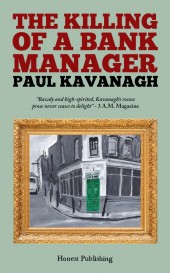‘The Killing of a Bank Manager’ by Paul Kavanagh
-Reviewed by Richard T. Watson–
It’s a title that must have sounded very of-the-moment back in 2010, when The Killing of a Bank Manager was first published. Remember when bankers were the bogeymen of Britain’s public consciousness? They’ve since been replaced by phone-hacking journalists and – at the time of writing – a BBC that seems at worst complicit in paedophilia and at best incompetent. But the grotty feel of these public scandals is still right at home in Paul Kavanagh’s diversely worded novella.
But don’t go thinking that this is any polemic on the evils of commercial banking. The bank manger appears near the start and the end, but for the rest of his killing is entirely absent. Instead, Kavanagh’s brutal and wide-ranging prose follows the dissatisfied butcher’s apprentice, Henry, who lives opposite the bank. It’s the story of a man in a world of his own, where all the people are somehow like people he’s read about or heard about somewhere else. Disconnected from everyone else’s reality, he’s invented his own by drawing in ideas and thoughts from a dozen other worlds.
We’re told of Henry’s journey around town – and his memories of previous events there – which isn’t a million miles from Harold Bloom’s journey in Joyce’s Ulysses. Henry too meets mythical creatures in human form, gives inside details on the process of digestion and reminds the reader of the close relation between human eating and animal digestion: the butcher holds up a knife ‘dripping blood and piss’.
Like Joyce, Kavanagh’s fond of his lists, listing the bones broken in an attack, the types of flies bursting from Henry’s body, the parts of animals dealt with by the butchers, rivers and things that are fake. Kavanagh’s lists go on for much longer than that one. They take the reader through every detail of, say, the dead animals being chopped by the butcher, layering towards an anatomical whole. Sometimes the list is Henry flailing around the for the right word, each one supplanting the one before. Sometimes, it’s almost as if Kavanagh wants to show you that he’s read up on species of flies.
Kavanagh knows how to write a breakdown; the book is full of physical and mental collapses, related in intimately graphic detail and all fairly unpleasant. It’s as if our main character – he’s not quite hero material, somehow – stumbles from one disorientating full-body shutdown to the next, via a series of increasingly surreal encounters. By the final pages, it’s a wonder that only the bank manager has been killed:
‘Rolling thunder broke his back. Henry was in Signorelli’s torture chamber. He tried to scream. His spine snapped. He felt his vertebrae undulate. Numbness started in the toes, he could not feel the fabric of his socks. His feet felt as though they would be erased. His legs would be next. He was being slowly rubbed out. Soon he would be nothing, not even a smudge.’
Signorelli is just one of the myriad external references Kavanagh – through Henry – draws into the novella. The text is littered with throwaway mentions and inferences from history, literature, art and mythology. Greek myths – Pan, and, yes, Odysseus – Dante, Archimboldo, Yeats, Don Quixote, Cravaggio, Shakespeare, Dali, Picasso, the Bible, Socrates, Euclid, Nostradamus, Persian myths, Petrarch and manuals on witch-hunting, besides many more. It makes his prose well-fertilised with ideas and thoughts that have gone before, though each of them is only ever really turned over, shown the light of day, and reburied. Like the introduction of Herman Melville’s Moby Dick – which I didn’t spot being referenced – The Killing of a Bank Manager‘s external references sometimes feel more like an invitation to see how widely the author has read, rather than necessarily being of service to the story.
The Killing of a Bank Manager takes the reader on a modern odyssey through the wide-ranging references of Paul Kavanagh’s reading, with a prose style that keeps them guessing and pulls no punches. Henry’s story flies about all over the place away from the initial concept of his love for the beautician downstairs and his hatred of the bank manager. As the blurb announces, ‘It’s never as simple as just the killing of a bank manager’.


